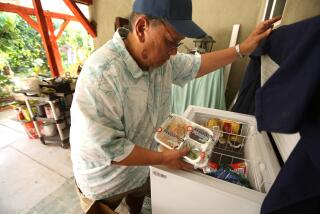San Gabriel Valley Gets Its 1st Food Pantry for People With HIV
- Share via
The mood is no less cheerful now at 191 N. Oak Ave. than when the Pasadena warehouse was a party accessories store.
The rows and rows of colorful streamers have been removed, and the happy clown-faced party plates are gone. But they’re not missed.
To the first few clients to set foot last week inside the San Gabriel Valley’s only food pantry for people who are HIV-positive, nothing was missing.
David Claypoole, 36, of Arcadia has been living on $622 a month for half a year. He has had full-blown AIDS for more than three years, but until last week never participated in a food pantry program.
AIDS Project Los Angeles has been serving people with AIDS at their West Hollywood food bank for 10 years, and an HIV-specific pantry opened up four years ago in East Los Angeles, but for San Gabriel Valley residents, it’s too far to drive, Claypoole said.
“Between time and gas and the wear and tear on the car, it just isn’t worth it,” he said, echoing a complaint that Dina Rosen, director of client services for the AIDS Service Center in Pasadena, said she heard too often.
The AIDS Service Center has provided health care, counseling and support to people with AIDS for the last nine years, Rosen said. And after three years of pushing, lobbying and campaigning, the center now also offers food.
“We knew we needed this because our clients were telling us,” Rosen said. “We have 700 to 1,000 people coming through our door [annually].”
That word-of-mouth assessment was reaffirmed by the San Gabriel Valley AIDS Consortium, which studied the needs of the area’s AIDS community.
“Food was the greatest issue,” Rosen said. “The San Gabriel Valley is getting such a low percentage of L.A. County funding [for AIDS], and the population keeps growing.”
Assemblywoman Diane Martinez (D-Monterey Park) helped push Rosen’s proposal through the Legislature, and earlier this year the state granted the center $60,000 to spend on food.
The food, which was purchased at a discount with AIDS Project Los Angeles, was stacked two boxes high on the pantry’s warehouse-size shelves for the initial distribution last week.
Only a handful of people had their paperwork ready to begin “shopping,” but the center expects to register 200 within a year. The clients can visit the pantry twice a month and fill out a “menu,” or checklist, of $15 to $20 worth of groceries each trip, said Karen Kerkow, the pantry’s program director.
Days before the launch, Kerkow teetered between ecstatic and frenetic, working constantly. to “just get the thing open already,” she said.
When it finally did open, staff and volunteers were thrilled. In the pantry’s modest waiting room, five volunteers arranged their chairs around Claypoole and Veronica Lamas, the assistant food pantry coordinator, who was running through an orientation.
When she was done, the volunteers applauded her before getting to work.
Because AIDS patients often have poor mobility, volunteers do all the legwork in the warehouse--grabbing food off the shelves, getting items out of the two industrial-size freezers and bagging the groceries--while the client sits in the waiting room.
“We’re hoping to get a TV in there,” said Chuck Heaton, 70. He and his wife, Rose, also 70, began volunteering with various AIDS projects five years ago, when their son died of the disease.
The Heatons filled the order while Claypoole--who left the waiting room to watch--looked on with delight.
“Gosh!” he gushed, while they filled a cart with his food. When his groceries were bagged, he thanked the crowd of staff and volunteers that gathered around the Heatons.
“We appreciate your business,” Chuck Heaton joked, looking just like a small-town grocer as he shook Claypoole’s hand. “Stop in again sometime.”
More to Read
Sign up for Essential California
The most important California stories and recommendations in your inbox every morning.
You may occasionally receive promotional content from the Los Angeles Times.













